its paid sponsors, whose products you need!
| Home |
| Intro |
| Current Issue |
|
Mailing List |
| Store |
| Strength |
| Subscriber Content |
| ARCHIVES
|
| Martialism |
| Pacifism |
| Q & A |
| Cunning-Hammery |
| Advertise With Us |
| Submit An Article |
| Staff |
| Discussion Forum |
| Links |
“Stay ‘unreasonable.’ If you
don’t like the solutions [available to you], come up with your
own.”
Dan Webre
The Martialist does not
constitute legal advice. It is for ENTERTAINMENT
PURPOSES ONLY.
Copyright © 2003-2004 Phil Elmore, all rights
reserved.
The Much-Maligned Mini-Revolver
By Phil Elmore
The scenario is entirely too familiar to law-abiding gun
owners. Licensed to carry concealed weapons (CCW) in their state or
municipalities, they discover that they cannot carry guns in the one place
where they spend a third to a half of every day. That place is on the
job, where many private and public companies have a host of policies in
place to which employees must adhere. Among the Internet abuse rules,
mandated hostile-work-environment training, hazard communications, and
on-site psychological and financial assistance can be found no shortage of
rules prohibiting firearms on the premises. At times, these rules extend
even to the parking lot of the workplace, which means no rifles locked in
trucks during deer season and no handguns locked in cars for
self-defense. Sure, each and every one of these working people could
choose to carry a licensed handgun but all it would take for each of
them to end up unemployed would be a single slip of a concealing outer
garment, a moments inattention to concealed carry in an environment
hostile to CCW.
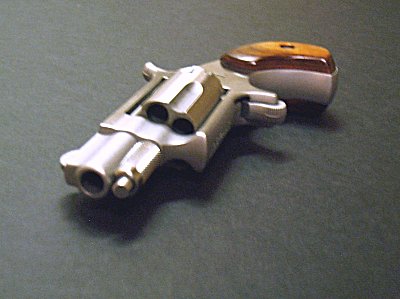
The situation could be less dramatic. Perhaps you live or
work in an environment requiring a very specific wardrobe one that leaves no
means of concealing even a compact handgun. Yes, even very large handguns
can be concealed inside your waistband under an outer shirt but what if
youre jogging in shorts and a t-shirt, working as a lifeguard in a pair of
swim trunks, or on the job at a hospital in scrubs or a nurses uniform? You
can easily construct hypothetical situations in which you can conceal a small
handgun (and even a hand cannon), but the fact remains that there are many
people for whom carrying and concealing daily even a small revolver or
automatic is problematic. For some of them, it is almost impossible, at least
without some risk of exposure. Yes, you can carry a hidden pocket automatic
in even the least permissive of environments but how long will it be before
you bump a desk, or drop your pants too quickly in a restroom stall, or
otherwise give someone nearby some hint that youre toting a sizeable chunk of
metal on your person?
Fortunately, there exists an
option between carrying a small gun, which is still too large to be
comfortable or completely discreet, and carrying no gun at all, which is no
choice for concerned citizens. That option is the smallest, most discreet
repeating firearm in production today. No larger than even the smallest
single-shot or multi-barrel pocket gun, smaller than any other factory
revolver or automatic for sale in this or any country (as far as I know), it
is the last choice for those who choose to be armed. It is the
North
American Arms (NAA) Mini-Revolver.
It was my father who
introduced me to the diminutive revolver. When I was a teenager he owned one
that he sometimes carried in a belt-buckle holster. While I would not
advocate such an audacious method of carry, the point is that Ive been
familiar with the little gun for many years now. Ive come to appreciate it,
despite its limitations. Unfortunately, many otherwise informed firearms
owners dismiss the Mini-Revolver as impractical. Most of the criticisms made
of this weapon are simply not valid if one takes the time to train and
practice with the gun.
Carrying and Shooting the
Mini-Revolver
The NAA Mini-Revolver, which can be had in multiple calibers
(including .22 Short, .22 LR, .22 Magnum, .17 HMR, and even a percussion black
powder version), is a single-action weapon with no trigger guard. The
cylinder on the .22 LR model holds five rounds and must be removed from the
gun completely to facilitate loading. The pin around which the cylinder
rotates must be removed before the cylinder will come out. The pin is used,
in turn, to poke empty cartridges out of the cylinder. As you might imagine,
loading and unloading is neither quick nor easy. If you are carrying this
pocket gun, you get only five shots before your revolver becomes a very small
paperweight.
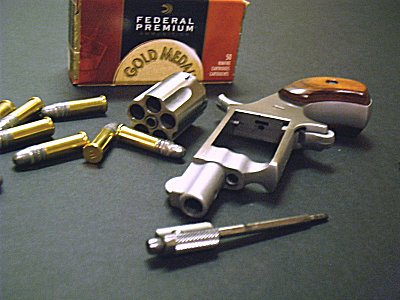
Fortunately, cautious citizens need not keep one chamber
empty for safe carry. The NAA Mini-Revolver incorporates notches between the
cylinders into which the hammer can be placed. This means there is no way
dropping the gun will accidentally fire it. You may load your NAA
Mini-Revolver with five rounds, carefully set the hammer down in one of the
notches, and carry it in your pocket without fear of accidental discharge.
The best way Ive found to carry the little gun is in a
pocket holster. The holster protects the gun from lint (though it will pick
up some nonetheless), keeps it oriented handle-up in the pocket, and breaks up
the outline of the weapon so it wont print as badly against the fabric of
your pants. I know of some people who carry the gun loose. It goes without
saying that nothing else should be in your gun pocket when you do this, to
prevent scratching the finish and to make sure nothing hinders your pocket
draw. That draw is not a quick-draw, of course; you wont be beating anyone
to the drop in digging for the weapon. This is a discreetly carried and
hopefully never used emergency firearm, not the latest tactical gunfight
accessory.
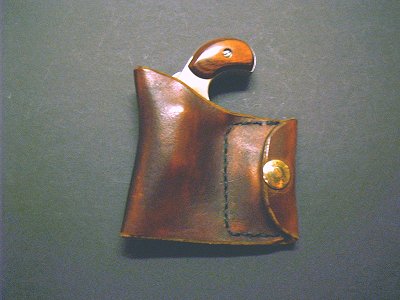
Firing the Mini-Revolver for the first time is a surprise to
most shooters. Even in .22 LR, the gun wants to jump out of the hand when it
goes off. It literally leaps up in your grip with every shot. The only way
to compensate for this and Ive learned to do it without difficulty is to
clamp down on the guns tiny birds head grip as if youre trying to choke the
life out of it. (Larger, more hand-filling grips are available as accessories
from NAA, but adding these compromises the small size that makes this gun
worth considering.)
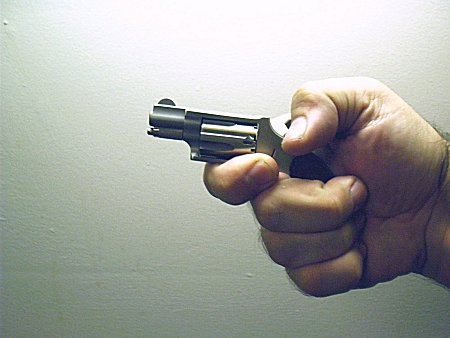
Such an aggressive grip on a firearm would play hell with
your marksmanship if the gun was designed to be fired at anything but
extremely close distances. Within its intended ranges, however, your
white-knuckle strangulation of the revolver wont hinder your ability to hit a
human-sized target.
Foolishly Dismissing the
Mini-Revolver
Surfing firearms sites on the Internet, Ive read a lot of
what I consider ignorant and misguided criticism of this gun. It seems many
shooters are too quick to dismiss the weapon, offering a variety of reasons
that simply dont hold up when one trains and practices with the
Mini-Revolver. I certainly would never begrudge anyone their preferences, but
I despise the tendency among some armed citizens to dismiss as unworkable,
impractical, or otherwise inferior those options that they do not themselves
prefer, or in which they cannot personally see value. Different
solutions work for different people and must be tailored to individual
requirements. Most of the criticism of this little gun revolves around
undervaluing the benefits of its incredibly small size, overstating
its liabilities, dismissing the improvements in performance gained through
proper training and practice, and projecting onto others ones own
biases and tastes.
If its that hard to index and control, one fellow told me,
that might tell you it isnt viable for use under stress. This is probably
the most common theme among those who at least recognize that a .22 Long Rifle
bullet, while not Dirty Harrys man-stopping .44 Magnum, is still not
something with which you want to be shot in the face.
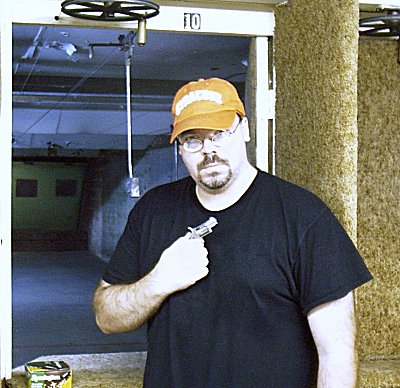
There is this myth among some shooters that anything smaller
than a .45 just wont kill you as if youre going to look down at the
seeping wound and demand indignantly of your assailant, What was that? A
.22? Thats it, now Im annoyed. Theres no denying that a very, very small
gun is harder to manipulate than is a much larger weapon just as most long
guns are easier to handle and manipulate under stress than are most handguns.
After all, its very easy to shoot yourself in a limb with a handgun and much
harder to do this with a rifle. What does that tell you about how hard it
must be to index and control a handgun under stress?
With proper practice, the shooter can learn not only to draw
the NAA Mini-Revolver, but also to clamp down on it and fire it, controlling
it for follow-up shots. Those who then shout that a single-action weapon is
too difficult to use under stress seem to have forgotten all that making equal
of men that Sam Colt managed with more or less the same mechanism. My
problem is not the caliber, said one critic, its the horrible ergonomics.
That ridiculously tiny grip and the need to cock it before each shot makes it
very hard to use under physical assault, to say the least. If all youve
ever known is a single-action trigger, youre going to learn to cock and fire
your gun every time. If you practice diligently, you will learn the same
lesson. Additionally, the NAA design fits the hand well despite its size. My
big mitt simply wants to grab it by the trigger and the hammer, in exactly the
position necessary to fire and fire again. This was not easy to do when I
started but after I tried it several times, I got better. This is the
lesson of training and the point of practice.
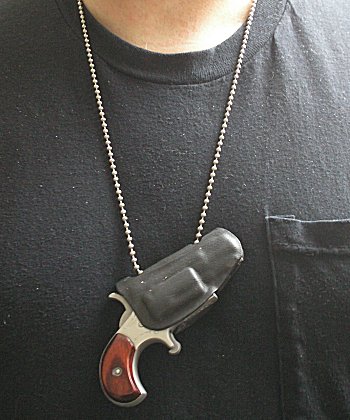
Why carry this piece of crap, demanded one irate
individual, when you can carry something else that is going to be more
effective and still fit in the same size envelope? The problem with this
thinking is that there is no revolver on the market smaller than the NAA.
Claiming that a pocket automatic that is even an inch longer and certainly
thicker not to mention heavier is just as good simply isnt so. When
youre forced to carry the smallest gun you can, its because you have very
little with which to work. Either you have a problem toting the weight or,
more likely, you cannot afford for anyone to even suspect that you might be
carrying more than a heavy set of keys. This is the niche into which the NAA
Mini-Revolver fits: totally discreet carry, carry that is more discreet than
anything else available. Claiming there are alternatives that are just as
good undervalues the weapons size while ignoring the liabilities of its
substitutes. The next smallest firearms are significantly larger than the
Mini-Revolver by comparison.
To those intent on projecting their own prejudices onto
others, the Mini-Revolver seems to fill one purpose, and one purpose only
[that of] a very small gun that can be carried absolutely anywhere for gun
fetishists, those who believe that, as long as they have a gun, no matter how
marginal its performance, theyll be okay. One fellow called the
Mini-Revolver the perfect example of gun as talisman. Fortunately, for
most serious shooters, guns are not magic wands and are not seen as such.
Most of us know the limitations of our weapons and we know that the gun wed
prefer to have isnt always the one we can choose. (To recognize this means
acknowledging that everyones situation is different, too, which is difficult
for some biased shooters to do.)
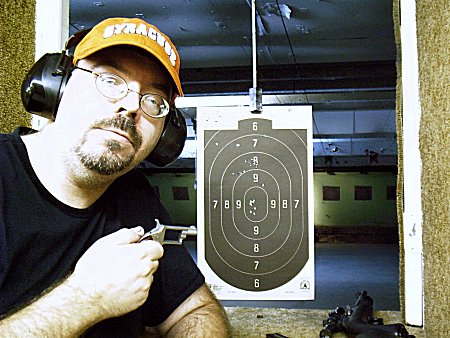
Who cares if its the smallest gun you can carry? one man
asked me. Its not a very effective weapon. There are plenty of more
effective weapons you can carry just as discreetly. …By saying that is the
niche that this gun fits into, youre saying that its a better idea to carry
this gun than it is to carry any of these other weapons, and that is simply
flat wrong. Well, no, Im not saying that and, no, Im not wrong. When I
say the NAA Mini-Revolver is a niche gun, which it is, Im saying its
designed to fit a very specific set of extremely discreet carry requirements.
There isnt another .22 caliber revolver of which Im aware that is as small
and thus there is no other revolver about which I know that you can carry with
the same degree of discretion.
If you know youll lose your job if a coworker spots your
gun, what would you choose? I dont advocate carrying in violation of
workplace rules, of course, and certainly never illegally but some of us
must make hard choices when faced with very real threats. What if youre a
woman who works in an office where carry is not allowed, but youre also being
stalked by a violent ex-boyfriend? Thats just one of several possible
scenarios in which you would want to carry a gun and you would want to carry
a gun that is the smallest you can get.
There is an entire class of automatic pocket pistols that are
small but, compared to the NAA Mini-Revolver, they are larger and
significantly heavier. They also depend on magazines, springs, moving slides
all things that I cant stand in a pocket pistol. I worry about the
magazine springs. I worry about lint interfering with the pistols
operation. I worry about what will happen if I get a misfeed or a stovepipe
in my little pocket auto. I worry and a single-action revolver eliminates
many of those worries while still being the smallest possible option to boot.
The gun is so small, in fact, that enclosed in its leather pocket sheath
it has been mistaken for a knife by some of my fellow shooters.
That brings us to those people who seem to think that a small
knife is as effective as, if not more so than, the Mini-Revolver. While at
contact distances a knife certainly is a very effective weapon, its still not
a projectile weapon. The NAA Mini-Revolver, despite its small caliber and
despite the short range at which you can expect to hit something with it, is
still a gun. It will still kill you and do so from a distance greater
than that at which you can stab someone. Unless you are a professional circus
knife thrower, youre out of luck when you snap open your Cold Steel Gunsite
II only to be shot in the face by a man standing just outside the range of
your lunge.
From the Owners Perspective
The Mini-Revolver has been around for thirty years and was
originally designed by Dick Casull, according to company owner Sandy
Chisholm. (You can find out more information on NAAs products by visiting
their website, naaminis.com.) Chisholm keeps an NAA Mini-Revolver in his
car but downplays the dangers he might face personally. My self-defense
strategy is largely, if theres somewhere that would be dangerous to me, I
dont go there, he told me. Of the little gun itself, he is more
forthcoming. We design it for those circumstances when its better than
no weapon at all, he explained. This is a product thats meant to be carried when a person wouldnt
otherwise carry a gun.
I discussed with
Sandy some of the
self-defense criticisms of the Mini-Revolver. If someone points a gun at
me, he said bluntly, regardless of caliber or size, thats going to change
my behavior.
What would you say to those who claim there are other small
guns, larger than the Mini-Revolver, that can do the same job and do it
better? I asked him.
We manufacture those, he said without hesitation.
The Mini-Revolver for
Self-Defense
Whether your choice is a
semi-automatic NAA Guardian in, say, .32 or .380, or you must opt for the more
discrete NAA min-revolver, any small-caliber defensive weapon is best used as
a face gun fired at close range into the face or neck. By close range I
mean as close at is it possible to get without being in range of a lunge from
the assailant, for if he can get close enough to touch you he can get close
enough to stab, punch, or grapple with you. Your strategy, generally, will be
to use your pocket weapon to gain the advantage, disabling or distracting the
aggressor (who has, if you have drawn a firearm, presented you with the
credible threat of imminent and grave injury or death) in order to escape.
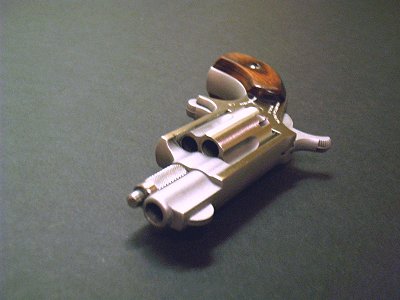
This is a modification of the
old stun and run principle in that youre not stunning, but inflicting
potentially lethal harm. There will be those reading this thinking, Getting
shot with that tiny gun isnt what Id call lethal harm. I dont know any
of them who would volunteer to be shot in the face or even a limb with a .22
of any power, however.
No weapon is a guarantee and
no gun is effective for everyone in all situations. Options solutions to
the problems of self-defense must be tested by the individual. You must
train, you must practice, and you must prepare. Without this, no amount of
theory and no vault full of hardware will help you. For some of us, the
discretion and the firepower offered by the NAA Mini-Revolver is the solution
to a very specific problem. Be mindful of this as you contemplate your own
solutions.
Resist the urge to malign a gun, no
matter how small, that is keeping a lot of people more safe than they
otherwise would be..
